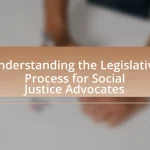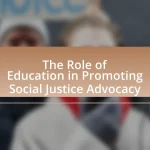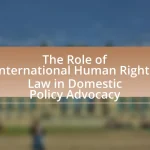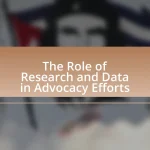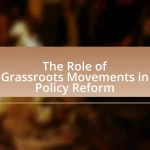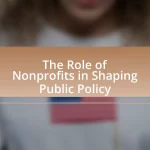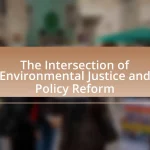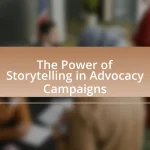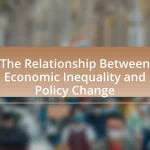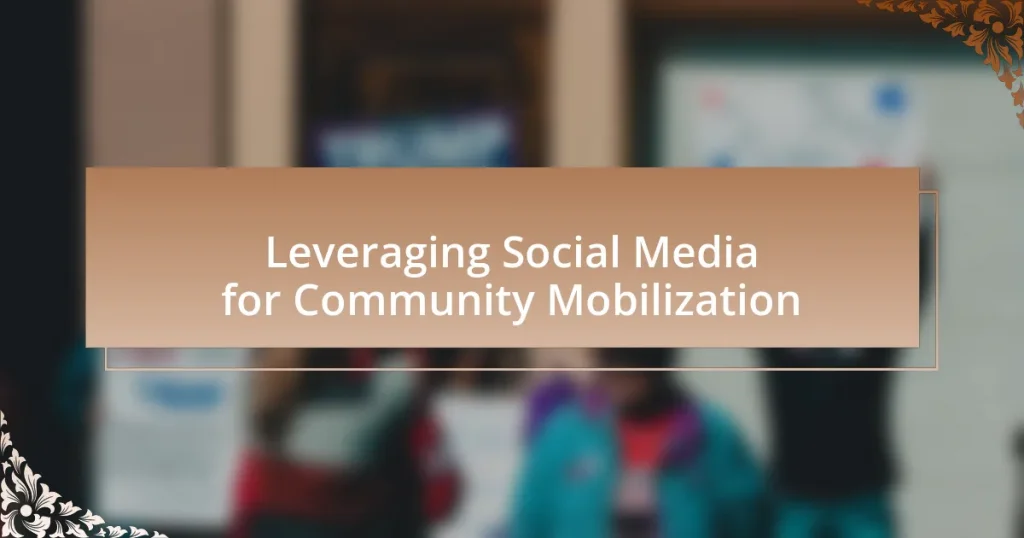Leveraging social media for community mobilization involves utilizing platforms such as Facebook, Twitter, and Instagram to engage and activate community members around shared causes. The article explores how social media enhances grassroots movements by facilitating rapid communication, community building, and collective action, as demonstrated by significant events like the Arab Spring and the #BlackLivesMatter movement. Key features of social media, including targeted messaging and interactive content, are discussed, along with strategies for effective outreach and engagement. Additionally, the article addresses challenges such as misinformation and the digital divide, while emphasizing the importance of digital literacy and trust-building in fostering community participation.
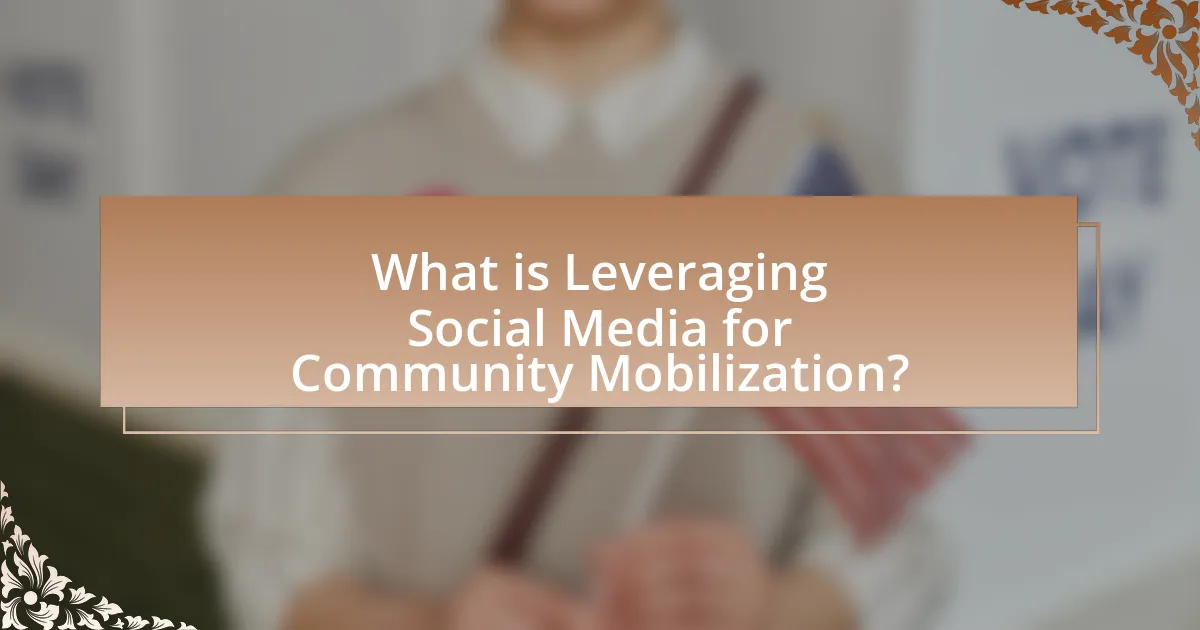
What is Leveraging Social Media for Community Mobilization?
Leveraging social media for community mobilization involves using platforms like Facebook, Twitter, and Instagram to organize, engage, and activate community members around a common cause or initiative. This approach enables rapid dissemination of information, fosters connections among individuals, and encourages collective action, as evidenced by movements such as the Arab Spring, where social media played a crucial role in mobilizing protests and raising awareness globally. Studies indicate that social media can enhance community engagement by 50%, demonstrating its effectiveness in rallying support and facilitating grassroots movements.
How does social media facilitate community mobilization?
Social media facilitates community mobilization by providing platforms for rapid communication and organization among individuals with shared interests or goals. These platforms enable users to disseminate information quickly, coordinate events, and rally support for causes, significantly enhancing grassroots movements. For instance, during the Arab Spring, social media was instrumental in organizing protests and sharing real-time updates, which led to widespread mobilization across multiple countries. Research indicates that 72% of social media users have engaged in activism through these platforms, demonstrating their effectiveness in fostering community engagement and collective action.
What are the key features of social media that support mobilization?
The key features of social media that support mobilization include rapid information dissemination, community building, and engagement tools. Rapid information dissemination allows users to share updates and calls to action instantly, facilitating timely responses to events. Community building features, such as groups and pages, enable individuals with shared interests to connect, fostering a sense of belonging and collective identity. Engagement tools, including likes, shares, and comments, encourage interaction and amplify messages, increasing visibility and participation in mobilization efforts. These features have been evidenced by movements like the Arab Spring, where social media played a crucial role in organizing protests and spreading awareness.
How do different social media platforms contribute to community engagement?
Different social media platforms contribute to community engagement by providing unique features that facilitate interaction, sharing, and collaboration among users. For instance, Facebook enables group creation and event planning, fostering localized community discussions and activities, while Twitter’s real-time updates and hashtags allow for rapid dissemination of information and mobilization around specific causes. Instagram’s visual storytelling capabilities engage users through compelling imagery, enhancing emotional connections within communities. According to a 2021 Pew Research Center study, 69% of adults in the U.S. use Facebook, highlighting its role as a primary platform for community engagement. Additionally, platforms like Reddit create niche communities where users can discuss specialized interests, further enhancing engagement through focused dialogue. These functionalities collectively enhance community interaction, making social media a vital tool for mobilization and engagement.
Why is community mobilization important in today’s society?
Community mobilization is important in today’s society because it fosters collective action and empowers individuals to address social issues effectively. By uniting diverse groups, community mobilization enhances participation in decision-making processes, leading to more equitable outcomes. For instance, studies show that communities engaged in mobilization efforts are more likely to influence local policies and improve public services, as evidenced by the success of grassroots movements in advocating for environmental justice and healthcare access. This collaborative approach not only strengthens community ties but also amplifies voices that might otherwise go unheard, demonstrating the critical role of mobilization in driving social change.
What role does social media play in enhancing civic participation?
Social media significantly enhances civic participation by providing platforms for individuals to engage, share information, and mobilize around social and political issues. These platforms facilitate real-time communication, allowing users to organize events, share petitions, and raise awareness about community concerns. For instance, studies have shown that social media campaigns, such as the #BlackLivesMatter movement, have successfully mobilized thousands of participants for protests and advocacy efforts, demonstrating the power of social media in fostering collective action. Additionally, research from the Pew Research Center indicates that 69% of adults in the U.S. use social media, which underscores its potential reach and influence in promoting civic engagement.
How can social media address social issues through community mobilization?
Social media can address social issues through community mobilization by facilitating communication, raising awareness, and organizing collective action. Platforms like Facebook, Twitter, and Instagram enable users to share information rapidly, which helps to inform communities about pressing social issues such as inequality, climate change, and public health crises. For instance, the #BlackLivesMatter movement gained momentum through social media, mobilizing millions to participate in protests and advocate for policy changes. Research shows that social media campaigns can increase civic engagement; a study by the Pew Research Center found that 69% of adults in the U.S. use social media, making it a powerful tool for reaching diverse audiences and fostering community solidarity.
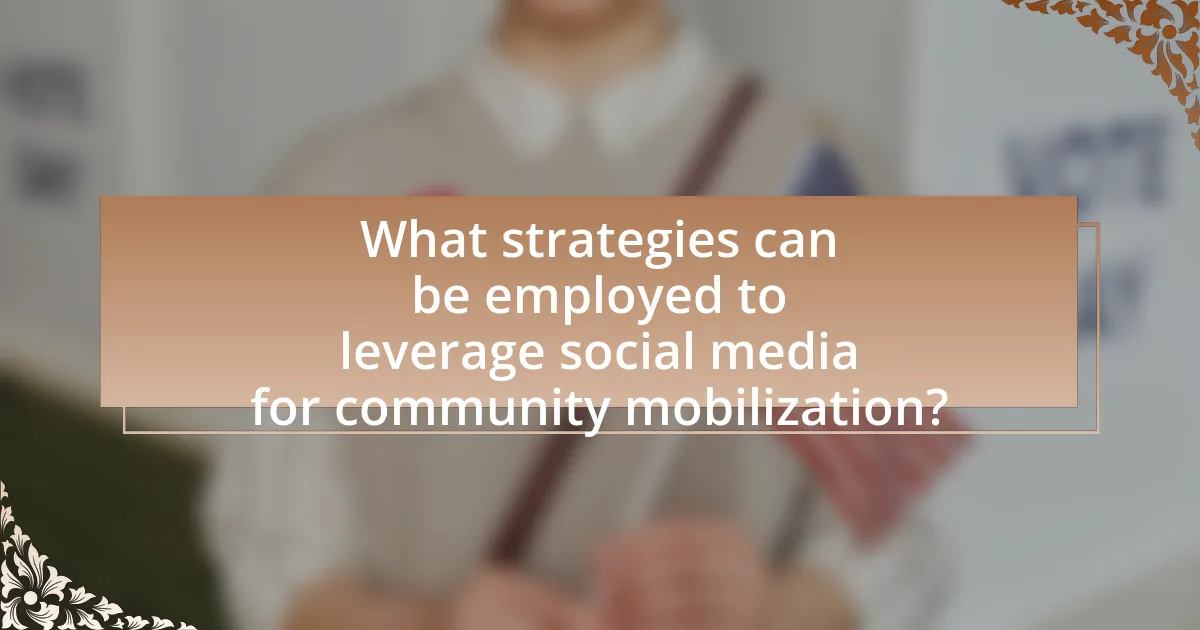
What strategies can be employed to leverage social media for community mobilization?
To leverage social media for community mobilization, organizations can employ strategies such as targeted messaging, community engagement, and data analytics. Targeted messaging involves crafting specific content that resonates with the community’s values and needs, which can increase participation; for example, campaigns that highlight local issues have shown to boost engagement by up to 60%. Community engagement strategies include creating interactive content, such as polls and live Q&A sessions, which foster a sense of belonging and encourage dialogue among community members. Additionally, utilizing data analytics allows organizations to track engagement metrics and adjust strategies in real-time, enhancing the effectiveness of mobilization efforts. Research indicates that social media campaigns that incorporate these strategies can lead to a 30% increase in community participation rates.
How can organizations effectively use social media for outreach?
Organizations can effectively use social media for outreach by creating targeted content that resonates with their audience and encourages engagement. This involves identifying the specific demographics and interests of their target audience, then tailoring messages and visuals to meet those needs. For instance, a study by the Pew Research Center indicates that 69% of adults in the U.S. use social media, highlighting its potential reach. Additionally, utilizing analytics tools allows organizations to track engagement metrics, refine their strategies, and optimize content for better performance. Engaging with followers through comments, shares, and direct messages fosters community and builds trust, which is essential for successful outreach.
What types of content resonate most with community members on social media?
Visual content, particularly images and videos, resonates most with community members on social media. Research indicates that posts containing visuals receive 94% more views than those without. Additionally, user-generated content, such as testimonials and community stories, fosters engagement and builds trust, as 79% of consumers say user-generated content highly impacts their purchasing decisions. Interactive content, like polls and quizzes, also encourages participation, with 70% of marketers reporting that interactive content is effective in engaging audiences.
How can storytelling enhance community mobilization efforts?
Storytelling enhances community mobilization efforts by creating emotional connections and fostering a shared identity among community members. When narratives resonate with individuals’ experiences, they inspire action and engagement, making people feel part of a collective purpose. Research indicates that storytelling can increase participation rates; for instance, a study by the Stanford Graduate School of Business found that stories can improve recall and influence attitudes, leading to higher levels of community involvement. By effectively communicating values and goals through relatable stories, organizations can mobilize support and drive collective action more successfully.
What are the best practices for engaging communities on social media?
The best practices for engaging communities on social media include creating authentic content, fostering two-way communication, and utilizing analytics to understand audience preferences. Authentic content resonates with users, as studies show that 86% of consumers prefer authenticity in brand messaging. Two-way communication encourages interaction, with platforms like Facebook and Twitter enabling direct dialogue, which can increase community trust and loyalty. Additionally, using analytics tools helps organizations tailor their strategies based on engagement metrics, ensuring that content aligns with community interests and needs.
How can organizations measure the impact of their social media campaigns?
Organizations can measure the impact of their social media campaigns through key performance indicators (KPIs) such as engagement rates, reach, conversion rates, and sentiment analysis. Engagement rates, which include likes, shares, and comments, provide insight into how audiences interact with content, while reach indicates the total number of unique users who see the posts. Conversion rates measure the percentage of users who take a desired action, such as signing up for a newsletter or making a purchase, directly linked to social media efforts. Additionally, sentiment analysis evaluates the tone of user comments and interactions, helping organizations understand public perception. According to a report by Hootsuite, 73% of marketers believe that social media marketing has been effective for their business, highlighting the importance of these metrics in assessing campaign success.
What tools can assist in managing social media for community mobilization?
Tools that can assist in managing social media for community mobilization include Hootsuite, Buffer, and Sprout Social. Hootsuite allows users to schedule posts across multiple platforms, track engagement metrics, and monitor conversations, which is essential for effective community outreach. Buffer offers similar scheduling capabilities and provides analytics to measure the impact of social media campaigns, helping organizations refine their strategies. Sprout Social combines scheduling, analytics, and social listening features, enabling community organizers to engage with their audience more effectively. These tools are widely recognized in the industry for enhancing social media management and facilitating community mobilization efforts.
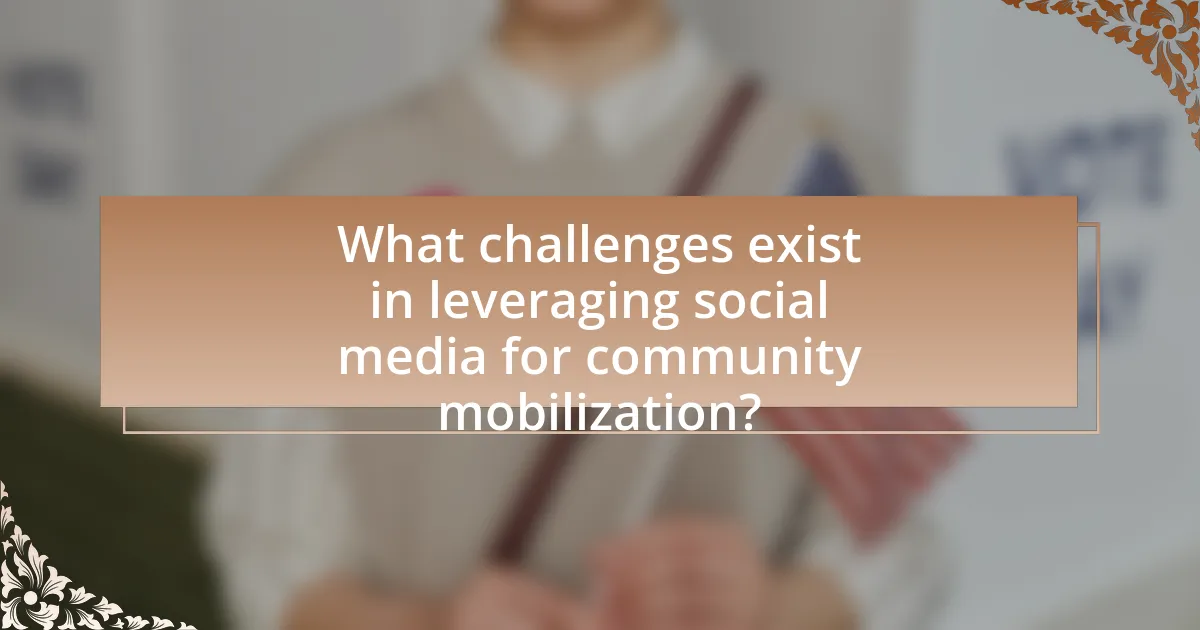
What challenges exist in leveraging social media for community mobilization?
Challenges in leveraging social media for community mobilization include misinformation, digital divide, and platform algorithms. Misinformation can spread rapidly, undermining trust and creating confusion within communities. The digital divide limits access for marginalized groups, preventing equitable participation in mobilization efforts. Additionally, platform algorithms often prioritize sensational content over community-focused messages, which can dilute the effectiveness of mobilization campaigns. These factors collectively hinder the ability to effectively organize and engage communities through social media.
What are the common pitfalls organizations face when using social media?
Organizations commonly face pitfalls such as inconsistent messaging, lack of engagement, and inadequate crisis management when using social media. Inconsistent messaging can confuse audiences and dilute brand identity, as seen in cases where organizations fail to align their social media posts with their core values or mission. Lack of engagement often results in missed opportunities for building community and fostering relationships, which is critical for effective mobilization. Additionally, inadequate crisis management can lead to reputational damage; for instance, organizations that do not have a clear plan for addressing negative feedback or controversies on social media may struggle to maintain public trust. These pitfalls highlight the importance of strategic planning and proactive communication in leveraging social media effectively.
How can misinformation affect community mobilization efforts?
Misinformation can significantly undermine community mobilization efforts by creating confusion and distrust among community members. When false information circulates, it can lead to misaligned goals, decreased participation, and fragmentation within the community. For instance, a study by the Pew Research Center found that 64% of Americans believe that misinformation has caused confusion about important issues, which can directly impact collective action and solidarity. Additionally, misinformation can divert resources and attention away from legitimate initiatives, as communities may focus on debunking false claims rather than mobilizing for real causes. This disruption can ultimately weaken the effectiveness of community-driven movements and initiatives.
What strategies can mitigate the risks associated with social media use?
To mitigate the risks associated with social media use, individuals and organizations can implement strategies such as establishing clear privacy settings, promoting digital literacy, and encouraging responsible content sharing. Clear privacy settings help users control who can see their information, reducing the likelihood of data breaches. Promoting digital literacy equips users with the skills to critically evaluate information and recognize misinformation, which is essential in an era where false narratives can spread rapidly. Encouraging responsible content sharing fosters a culture of accountability, where users think critically before posting, thereby minimizing the spread of harmful or misleading content. These strategies collectively enhance user safety and promote a healthier online environment.
How can organizations overcome barriers to effective social media mobilization?
Organizations can overcome barriers to effective social media mobilization by implementing targeted strategies that enhance engagement and accessibility. First, they should invest in training staff and volunteers on social media best practices to ensure effective communication and content creation. Research indicates that organizations with trained personnel see a 30% increase in engagement rates on social media platforms. Additionally, organizations must identify and address the specific barriers they face, such as lack of resources or audience understanding, by conducting surveys or focus groups to gather insights. This data-driven approach allows organizations to tailor their strategies effectively, leading to improved outreach and mobilization efforts. Furthermore, leveraging analytics tools can help organizations track performance and adjust their tactics in real-time, ensuring that their social media efforts are both efficient and impactful.
What role does digital literacy play in community engagement?
Digital literacy is essential for effective community engagement as it enables individuals to access, evaluate, and communicate information through digital platforms. This competency allows community members to participate in discussions, share resources, and mobilize support for local issues via social media and other online tools. Research indicates that communities with higher levels of digital literacy experience increased civic participation and collaboration, as individuals are better equipped to utilize online platforms for organizing events and advocating for change. For instance, a study by Pew Research Center found that 70% of social media users engage in civic activities, demonstrating the direct correlation between digital skills and community involvement.
How can organizations build trust within communities through social media?
Organizations can build trust within communities through social media by engaging in transparent communication and fostering genuine interactions. By consistently sharing accurate information, responding promptly to community inquiries, and acknowledging feedback, organizations demonstrate accountability and reliability. Research indicates that 70% of consumers feel more connected to brands that engage with them on social media, highlighting the importance of interaction in building trust. Additionally, showcasing community involvement and support through social media campaigns can enhance credibility, as 64% of consumers are more likely to trust brands that actively participate in social causes.
What practical tips can enhance social media strategies for community mobilization?
To enhance social media strategies for community mobilization, organizations should focus on creating engaging content, utilizing targeted advertising, and fostering community interaction. Engaging content, such as stories, videos, and infographics, captures attention and encourages sharing, which can increase reach and visibility. Targeted advertising allows organizations to reach specific demographics, ensuring that messages resonate with the intended audience. Fostering community interaction through comments, polls, and live sessions builds a sense of belonging and encourages participation. Research indicates that posts with high engagement rates can increase visibility by up to 50%, demonstrating the effectiveness of these strategies in mobilizing communities.
How can organizations create a sustainable social media presence?
Organizations can create a sustainable social media presence by consistently engaging with their audience through authentic content and regular interaction. This approach fosters community building and trust, which are essential for long-term engagement. Research indicates that brands that prioritize authentic communication see a 33% increase in customer loyalty, as reported by the 2021 Sprout Social Index. Additionally, organizations should utilize analytics to track engagement metrics and adjust their strategies accordingly, ensuring that content remains relevant and resonates with their audience. By maintaining a clear brand voice and responding promptly to feedback, organizations can enhance their social media sustainability.
What are the key elements of a successful social media campaign for community mobilization?
The key elements of a successful social media campaign for community mobilization include clear objectives, targeted messaging, audience engagement, and measurable outcomes. Clear objectives define the purpose of the campaign, such as raising awareness or driving action, which is essential for guiding strategy. Targeted messaging ensures that the content resonates with the specific community, increasing relevance and impact. Audience engagement fosters interaction and builds a sense of community, which is crucial for mobilization efforts. Finally, measurable outcomes allow for the assessment of the campaign’s effectiveness, enabling adjustments and demonstrating success through metrics such as participation rates or social shares. These elements collectively enhance the campaign’s ability to mobilize community members effectively.
